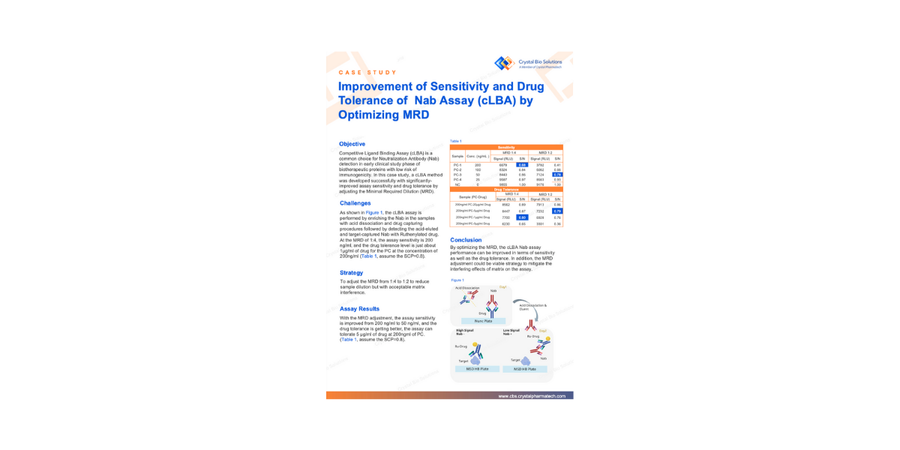Oct 9, 2025
Improving the Sensitivity and Drug Tolerance of a NAb Assay by Optimizing MRD
Optimizing the Minimal Required Dilution (MRD) in a cLBA NAb assay improved sensitivity fourfold and drug tolerance fivefold, enhancing assay reliability.
 \
\
Neutralizing antibody (NAb) assays are essential tools for evaluating the immunogenicity of biotherapeutic proteins. Among the different assay formats, Competitive Ligand Binding Assays (cLBA) are widely used in early-phase studies for therapeutics with a lower immunogenicity risk.
In this case study, Crystal Bio Solutions developed a cLBA method with significantly improved assay sensitivity and drug tolerance through a simple yet powerful adjustment of one parameter, the Minimal Required Dilution (MRD).
The Challenge of Balancing Sensitivity and Drug Tolerance
In NAb assays, a key goal is to detect low levels of anti-drug antibodies even in the presence of residual drug. However, matrix effects and excessive sample dilution can compromise assay performance.
In the initial setup, using an MRD of 1:4, the assay showed:
-
Sensitivity: 200 ng/mL
-
Drug tolerance: 1 µg/mL of drug at 200 ng/mL of positive control (PC)
This level of detection was sufficient for some studies but limited for samples with low antibody levels or higher drug concentrations. The team aimed to reduce the MRD while maintaining acceptable background interference.
Developing the Optimization Strategy
Our scientists optimized the MRD from 1:4 to 1:2, effectively reducing sample dilution and allowing higher signal recovery.
This modification enhanced both sensitivity and drug tolerance, as shown in assay validation results:
-
Sensitivity improved from 200 ng/mL → 50 ng/mL
-
Drug tolerance increased from 1 µg/mL → 5 µg/mL
By minimizing unnecessary dilution, the assay retained more detectable antibodies and improved the ability to measure true NAb activity, even in drug-rich samples.
Results: Fourfold Sensitivity Increase and Stronger Drug Tolerance
The optimized assay demonstrated:
-
Improved signal-to-noise ratios across all positive control concentrations
-
Enhanced detection of low-level NAbs without compromising specificity
-
Robust tolerance to drug interference up to 5 µg/mL
These outcomes confirm that adjusting MRD can significantly strengthen the performance of cLBA-based NAb assays without altering their fundamental structure.
Developing Why MRD Optimization Matters in NAb Assay Design
For biotherapeutic programs, understanding and controlling immunogenicity is crucial to ensure clinical safety and efficacy.
An assay that is both sensitive and drug-tolerant enables:
-
More accurate characterization of immune responses
-
Improved decision-making in early clinical phases
-
Greater confidence in regulatory submissions
By optimizing MRD, Crystal Bio Solutions provides a cost-effective and scientifically grounded approach to enhance NAb assay reliability.
Key Takeaways
-
Adjusting MRD from 1:4 to 1:2 enhanced both sensitivity and drug tolerance
-
Sensitivity improved fourfold (200 → 50 ng/mL)
-
Drug tolerance increased fivefold (1 → 5 µg/mL)
-
The approach mitigates matrix interference while preserving assay integrity
-
A practical strategy to improve cLBA performance in early-phase immunogenicity testing
📥📎 Access the case study

